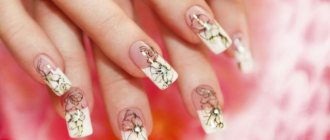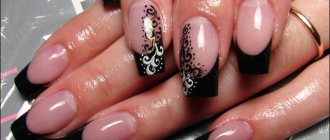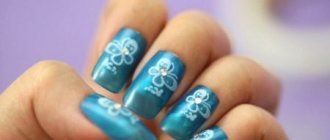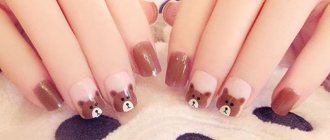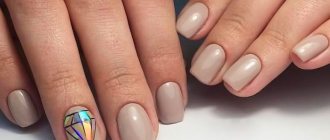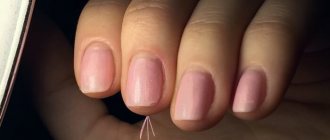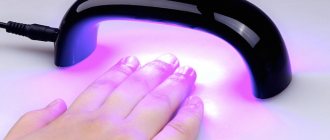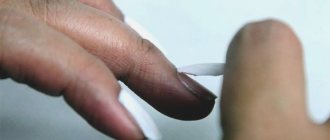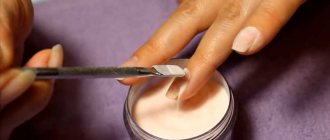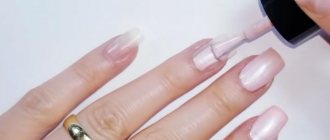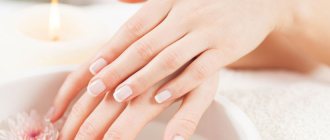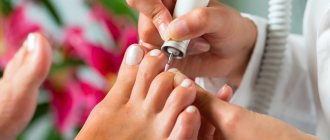Nail extension is a technology that helps girls look beautiful and well-groomed. This procedure saves many representatives of the fair sex, who by nature do not have a very beautiful shape, weak and brittle nails. Extended nails are a guarantee of charming hands that do not require much care than real ones. You only need to go for correction once every 3-4 weeks and moisturize your hand skin with a high-quality cream.
Of course, everyone has heard, and many girls have done this popular procedure in salons. We will tell you step by step how you can learn how to do nail extensions at home. It’s quite possible to do this, the most important thing is to be purposeful, have a little patience, know the technology, and have all the materials and tools. To make your manicure perfect, you need to train for a long time, devote a lot of time and put in effort. The biggest problem with doing nail extensions at home is that you have to do the manicure with one hand, which causes a lot of inconvenience. But there is a big plus - you will save money and in the future you will be a real master for yourself.
First you need to choose and prepare a convenient place for nail extensions. A small table and a comfortable chair will suit you best. Only the necessary things for the procedure should be on the table; remove all unnecessary items so that they do not interfere with you. Set aside about 4 hours of free time. Now decide which extension method will be best for you: false nails (tips), gel or acrylic.
Safe choice of glue
The artificial nails were always supplied with a special glue, which was not very convenient for gluing them. And all because there was not enough of it and it was not too active to adhere the plastic to the nail tightly enough. Instead of such glue, many girls had to resort to superglue, which has a bad effect on the body due to toxic compounds inside it.
To avoid this, you need to prepare safe glue in advance, which can be purchased in specialized stores.
BOHEMIA glue is a thick, viscous glue that has a pungent odor. It quickly adheres the artificial nail surface to the natural nail.
SR Beauty glue - this glue is waterproof and heat-resistant and can withstand mechanical damage well. Despite the pungent odor, this glue is in high demand, as it quickly and reliably attaches artificial tips to a natural nail.
Features of different types of nail extensions
Different types of nail extensions differ in the use of base materials. How long such a manicure lasts will depend on what material is chosen for nail extensions.
The main nuance of extensions is possible allergic reactions to one or another composition used. Therefore, if you feel any discomfort during or after the procedure, be sure to inform the master about it. He will select the most suitable composition for you.
@cosmetic_shop_sevas
Gel, biogel or polygel
It won’t be difficult to figure out how these materials differ from each other if you know how each of them is used:
- The gel has a synthetic composition and becomes hard only after using a UV lamp. Gel nail extensions allow you to create almost any length and make your nails very hard. It is possible to create nails up to 5 mm thick. It has a transparent glass-like structure. Repeated extension is required no earlier than after 3-4 weeks.
- Biogel consists mainly of natural ingredients and includes vitamins to strengthen your own nails. It has a wide range of colors, which allows you to immediately create beautiful nail designs. It is mainly used to strengthen the natural nail plate. Biogel does not promote nail extension as such; it has an elastic structure. Repeated extension is required after 2-3 weeks.
- Polygel in its properties resembles gel and acrylic, which is a big advantage over other compositions. The hardened material retains its plasticity, does not spread immediately after application and does not dry out during the formation process. Does not heat up during polymerization. Shades – nude, transparent and white.
When choosing between these materials, rely on your own needs. If you need to strengthen your natural nails, choose biogel. If you want strong and long nails, you need gel. Polygel will be useful for those who want a long-lasting, beautiful design and turn to a trusted craftsman, because not everyone can work with this material efficiently.
Acrylic
Acrylic nail extensions involve mixing acrylic powder with a monomer. Thanks to this, a quickly hardening mass is obtained, which must be applied to natural nails, evenly distributing it over the entire plate.
With acrylic it is possible to extend nails to any length, and the range of colors allows you to immediately create the desired manicure design.
@nails_shop_mein
How to properly glue artificial nails
When the desired glue is selected, we get to work. The first step is to get your natural nails in order and for this you need to do a home manicure. When the cuticles are processed and the length of the nails has the desired shape and size (do not cut the nails at the root; false nails need a short length to stay on), then degrease the surface of the nail with acetone.
Then we apply glue to the nail and immediately glue the artificial tip to it. Press and wait 30 seconds. Then we repeat the same with the rest of the nails, and then we cut the tips, if necessary, and shape the shape with a nail file.
The final stage is painting the artificial nails and securing the varnish with a finishing topcoat.
What types can be
Plates are distinguished according to different parameters, the main one being material. The following tips are considered the most popular.
Made from nylon
It is well modeled and follows the shape of a natural nail, ideal for professional nail art.
From polyflex
This material allows the pad to be flexible and provides adhesion to other polymers. Thanks to the composition of polyflex, the design and decoration of nails, like the tips themselves, will not peel off.
Made of plastic
Modern manufacturers of high-quality linings add substances to the usual plastic tips that can reliably adhere the plate to other polymers. At the moment, plastic tips are the most popular among nail artists.
In addition to the characteristics of the material, tips also differ in shape. Classic onlays are curved, follow the natural shape of the nail and are suitable for most nails that have not previously been injured. Stiletto overlays are most often used for designs or as the basis for another shape, as we noted above. And to create a French manicure, masters often use straight tips without a contact zone. This means that the overlays are not glued to the nail, but are attached to it end-to-end.
Another category by which tips are distinguished is the color base. Most often they prefer transparent overlays that can be painted in any shade. Nude base plates are used to avoid additional camouflage.
Colored tips significantly reduce the time spent in the salon, but working with them requires knowledge of the technology and basics of manicure with overlays. Therefore, it is better not to do them for novice masters. There are also options with ready-made French: on such plates the ideal light line is already prepared in advance.
How to remove false nails
To remove false nails you need to pour water into a bowl, which needs to be heated to 50 degrees. Immerse your fingers in the water for 25-30 minutes. When the time is up, use an orange stick to carefully lift the false nails and remove the layer of glue using a cotton swab soaked in acetone.
After removing artificial nails, it is recommended to rub nourishing oils into the nails to restore the natural layer.
Pros and cons of using
First let's talk about the benefits:
- Press-on nails are cheap and easy to find at nail supply and supply stores.
- There is a large selection of coating colors and designs, so you can buy several different ones at once in reserve.
- They are easy to use, so there is no need to go to the salon, this also has its own savings.
- Gluing on false nails takes only a few minutes, and the result is sometimes indistinguishable from a professional manicure.
- Suitable for children.
- If used correctly, the nails will not cause any harm to the nail plate.
And now about the disadvantages:
- Improper gluing will cause damage to the natural nail plate. Therefore, carefully study the instructions. We will talk about this separately.
- It is not always easy to choose false nails to fit the size of the nail plate. Still, it is individual for everyone, so most likely you will have to file them a little in width. Manufacturers usually include tips for such purposes not for 10 nails, but with a reserve.
- It is important not only to attach your nails correctly, but also to use them in everyday life in compliance with certain rules. We will also look at this in more detail below.
False nails are not a complete replacement for a manicure with a decorative coating. Therefore, you should not compare them; after all, professional materials are professional because they are used in a completely different way.
Nail care and removal
A few words need to be said separately about caring for such nails. Do not wet your feet excessively and wash off the polish with a liquid containing acetone. In addition, due to the possibility of artificial plates peeling off, it is better to buy and always have a spare set on hand. This will save you from awkward situations.
Each type of nails for false pedicure has its own removal method. Some are simply removed using warm water, others using a special solvent. In any case, you need to read the instructions and under no circumstances tear off your nails, as this risks damaging the natural nail plate.
Thus, we can say that false nails can be a lifesaver in many cases. You shouldn't overuse them or apply them often, but sometimes they are really necessary. They are quick and convenient to apply, and very easy to remove, so they can easily replace a full-fledged pedicure on special occasions.
Types of nails
For those who want to make their hands attractive and well-groomed today, there are several options:
- False nails - plates are glued to the nails using special glue.
- Extended acrylic nails - the material hardens when exposed to air. At the end of wearing, it is dissolved with a special liquid.
- Extended gel nails - the material is applied to the nail plates and hardens under an ultraviolet lamp. After wearing, the artificial nails are filed with a coarse file.
Login to the site
Getting acrylic nails seems like such a tempting idea. False nails will last much longer than regular polish, are easy to maintain, and also give you the opportunity to get strong and long nails instead of those short natural nails that acrylics make some people look ugly. But the side effects of this beauty can be terrible.What woman doesn't dream of long, beautiful nails? Looking at the commercial success of the industry associated with the creation of false nails (production of materials, salons, courses for nail technicians, etc.) it becomes obvious that women are not only willing to spend money on artificial nails, but also, sometimes, put their own health at risk. As with any cosmetics, before applying false nails, you need to consider all possible side effects, moreover, synthetic substances, which include acrylic and gel used to create nails, are rarely completely safe.
What is the problem?
- Firstly, the chemicals that are used to strengthen false nails are very harmful to health - they contain resins and formaldehydes, which can, under some circumstances, lead to the development of cancer. Prolonged exposure of nails to these substances can cause nail loss due to damage to the nail matrix. — Secondly, the artificial nail is attached to the natural nail almost as tightly as a natural nail is attached to the nail bed. Damage to the artificial nail can cause the natural nail to lift slightly above the nail bed, creating a warm, vital environment between them that is ideal for bacteria and fungal organisms to thrive. Due to the layer of acrylic or gel, signs of infection will not be immediately noticeable, and the longer you wear false nails, the more serious the consequences of infection can be. - Thirdly, false nails draw out natural oils from natural nails, as a result of which the nail plate becomes thin and brittle. In some cases, severe damage to artificial nails leads to infection and even loss of your nail. Acrylics and gels can cause a serious allergic reaction, sometimes resulting in inflammation and thinning of the nail bed. Full recovery of nails after this may take more than a year.
Food for thought: Some hospitals prohibit staff from wearing false nails due to the increased risk of infection they pose to patients. In the late 90s of the 20th century, several newborns born prematurely died due to an infection, the pathogens of which lived under the acrylic nails of a nurse.
Some salons use nail adhesives that contain the toxic substance methyl methacrylate (MMA). It is an ingredient in some liquid monomers that are used to create acrylic nails. MMA can cause serious damage to the lungs and can also cause permanent damage to natural nails. Other possible side effects of MMA use include severe allergic reactions, permanent loss of sensation in the fingertips, and irritation of the nose and throat. In many countries, the use of MMA in beauty salons is strictly prohibited.
Dibutyl phthalate is a plasticizer found in many nail polishes and acrylic and gel extension products. It has harmful effects on the reproductive system and can cause various birth defects. Its use is banned in the European Union, but it is still widely used in numerous regions.
Choose natural
Nowadays, there are environmentally friendly nail polishes that can also be used to create a beautiful manicure. These varnishes do not contain dibutyl phthalate, parabens, formaldehyde and toluene. They may not make your nails as long or strong as fake nails, but they will protect you from some harmful chemicals and help you save the planet you live on.
Can acrylic damage natural nails?
According to experts, in general, the likelihood that acrylic nails will harm natural nails is low. However, those who decide to undergo extensions should still exercise caution.
Sometimes a gap appears between the acrylic and natural nails. For example, if you hit or catch your acrylic nail on something, it may become detached from the natural nail in some places. The resulting space creates a warm and humid environment, ideal for the proliferation of infectious agents. Infection can also develop if acrylic nails are too long or too hard, or if unsterile tools were used to apply the extensions. When infected, the natural nail typically becomes thicker, begins to peel, and changes color.
Some women experience allergic reactions to components of substances used for nail extensions. Allergy symptoms may include redness, swelling and pain around the nail plate.
To minimize risks, when choosing a salon where you will get your nails done, take the following measures:
— Choose only those salons that have a license and employ people who have the necessary training; - Pay attention to smells. If there is any odor in the cabin, it may be a sign of poor ventilation. Good ventilation when working with chemicals is very important for the normal well-being of salon workers and clients; - Make sure your nail technician properly sterilizes their tools and washes their hands thoroughly before working on a new client. — Before applying extensions, you need to soak your nails in warm soapy water for a couple of minutes. If the master ignores this requirement, this most likely indicates his lack of professionalism; - Do not allow cuticles to be trimmed or pushed back before applying extensions. This increases the risk of infection; - Do not allow the surface of your nails to be sanded before acrylic nails are attached to them. This will make your nails weaker; — Ask the nail technician to use a new nail file, or bring your own file to the salon. Due to the nature of the material from which they are made, files are difficult to completely clean of germs that may have been left behind by previous customers. If you are doing acrylic extensions, follow the instructions on the package of materials and tools. It is very important to work in a well-ventilated area and protect the skin around the nails from exposure to chemicals used for extensions.
If you suspect you have an infection or are experiencing symptoms such as redness, swelling or pain around your nail, consult your dermatologist.
Link: Medical Truth
Stages of the procedure
Firstly, it should be said that when choosing a set of false nails, you should pay attention to their size and thickness. High-quality overlays should not be too voluminous, otherwise they will stick out above the nail plate. The width and length are selected based on the parameters of natural nails. If no set seems suitable, do not be upset, as artificial nails can be easily trimmed and filed to the required shape.
It is imperative to pay attention to the presence or absence of special glue for attaching nails in the kit. If it is not there, then you need to ask the consultant in the store to select a suitable option. You should not skimp on the adhesive, as it determines how long your nails will last.
Stages:
- Immediately before the procedure, you must first remove any remaining polish from your natural nails. After this, a special softening agent is applied to the cuticle. After a couple of minutes, you need to remove it with a napkin, and carefully push the skin away with an orange stick so that the border of the artificial nail is as close to the skin as possible.
- Next, you should carefully sand the nail plate. There should be no irregularities or bumps on it. The free edge is trimmed or filed as necessary. Nails should not be too long. Now you need to remove any dirt and greasy layer from their surface. This can be done either using nail polish remover or using a special degreasing liquid.
- It's time to move on to the false nails themselves. You need to prepare them for gluing. Their size should match the parameters of the natural nail plate, so they can be carefully trimmed or filed to the required state. After this, glue is applied to the inside of the plates, and they are applied and pressed tightly to the nail. It is better to hold them with your hand for 30–40 seconds until they are completely glued. Repeat the procedure on all fingers.
Depending on the type of false nails, they can either be varnished or left as is. Pedicure is ready.
Acrylic nails
The trend of the last decade is permanent acrylic and gel nails. It seems that in the beauty world there has never been such an invention that would simply blow up the world. But everything is changing, and fashionistas can fully enjoy the perfect manicure for several weeks.
The procedure for acrylic nail extensions is quite simple. The powder is mixed with a special liquid, stirring thoroughly. Afterwards, a small “pea” is applied to the nail, and using a brush, the nail is modeled, as if smoothing out this mass. They make sawdust, giving it the desired shape. Next, color, design and other procedures are applied.
Acrylic nails are very durable and tolerate temperature changes well, so they perform well in the cold season. The only disadvantage of acrylic extensions is the terrible smell that appears when mixing powder and liquid. Because of this, many women prefer gel extensions.
